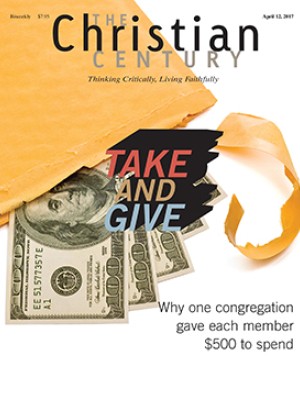There’s an identity crisis going on in this text from John. Who’s who? And what are they supposed to represent?
There’s a sheepfold. It must be a pretty special place, because thieves and bandits are trying to get inside. Is the sheepfold heaven, communion with God, a relationship with Jesus? Are the thieves and bandits those who haven’t earned that reward, that communion, that relationship? Whatever it is, it seems like a place we’d like to go to. So we must be the ones who need to be let in.
But then we learn that the one who enters the gate is the shepherd. The shepherd is in charge of the sheep, so that can’t possibly be us. Also, if we read ahead to verse 11, we learn that Jesus is the shepherd, so that must be who John is talking about.
Read our latest issue or browse back issues.
But if Jesus is the shepherd, who’s this gatekeeper? Who would be letting Jesus in to the sheep? God? Wasn’t God the bridge to humanity when Jesus was born? We read that story just a few months ago. And now Jesus is the shepherd and God is the gatekeeper? It’s difficult for us to understand. John says Jesus’ listeners don’t get it, either.
So Jesus clarifies, or tries to: “I am the gate for the sheep.” Wait a minute, wasn’t the gate just a gate before, just an inanimate object? Now Jesus is the gate—so who’s the shepherd, the one whose voice the sheep recognize? And who is the gatekeeper, the one swinging Jesus open and closed for the shepherd to enter? It sounds like a poorly written, poorly delivered Abbott and Costello routine.
It may be that we have here the conflation of a number of parables. Taken independently, Jesus can be the gate that separates the sheep from the world outside, or the gatekeeper who lets people in and keeps people out, or the shepherd whose voice the sheep know. It works when we separate the metaphors.
But that’s not the real problem with this text. The real problem is the sheepfold we started with. While theologians and clergy are playing the who’s who game, another audience hears this text and focuses on the sheepfold. A sheepfold can do only two things: hold something in or keep something out.
Now, those sitting in their pews, religiously, on Sunday morning may love the image this conjures. They’re in the sheepfold, grazing on the lush green grasses, following the sound of the shepherd’s voice, being led beside still waters, and protected when they leave the fold to journey through those dark valleys to their next grazing spot. What could be more serene? Say the 23rd Psalm, sing “God Will Take Care of You,” and the service is complete.
But there’s a new young woman in worship on Sunday. She slips in shyly, beneath the “All Are Welcome” banner, and makes her way to the balcony, hoping not to be noticed. She’s really not sure why she’s here, but deep down she is hoping maybe there’s a word she can hear that will help her deal with the alienation she has felt from the church since she came out to her family years ago. She, too, is fixated on that sheepfold. There are sheep inside, she thinks, and I’m not one of them. And there’s a barrier to getting in—the church wants to keep me out. I’m not good enough; I haven’t been faithful enough. God doesn’t love me for who I am. The sheepfold will never be for me, because I’m the one the gate is intended to keep out. So she slips out before the benediction, as quickly as she entered, realizing, once again, that the church is not the place for her.
In John’s context, his intention seems clear: make a relationship with Jesus something to be coveted. Make those Jews who may still be wondering about Jesus start to believe in him. Make the gentiles see that there’s something here for them as well. But today this attempt at getting people into the sheepfold often feels more like an attempt to keep other people out. To the LGBTQ community, to the single mother, to the divorced father, to the teenager battling depression, to the young family whose car isn’t nearly as fancy as the ones parked next to it, to the couple who have never been to church before—the sheepfold feels exclusive, unattainable, unwelcoming. This is the real problem with the text.
It’s not the identity crisis, it’s the location crisis: From where do we hear this text? Inside the church it feels inclusive and loving; outside the church it feels exclusive and marginalizing. That’s a problem. It’s not the message Jesus was trying to give then, and it’s not a message the church can afford to give people now.
So tear down the sheepfold, remove the gate, do away with the gatekeeper. Allow the sheep to roam freely in the world and let God be the Good Shepherd of the psalm, roaming with all the sheep, chasing after them with goodness and mercy flowing everywhere. Or at least show a gate that doesn’t close anymore. And then hope that the young woman in the balcony is listening.






